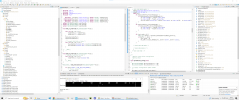The F411 boards have 4 I2S I believe, might be 6. However they have enough CPU power to run maybe 1 or 2 IIR filters.
The chips I gravitated towards are the H7s. The H743 and H750 are available in module form from Aliexpress. Expensive at around £35 these days. It has an ARM M7 Core @480MHz with a double precision float point unit and DSP extension hardware. The difference, asides price is the 743 has 2Mb of FLASH where as the 750 only has 128kb flash. The 750 is fine for audio. You don't need flash for media.
A few notes. The H7s can be a bit fiddly. They are more complex than the F4s, multiple memory segments, multiple memory and DMA buses, multiple bus matrixes. If STMs are not yet your thing, it might be worth starting with an F4 where everthing is flat. The advantage other than the power is the 4xSAI peripherals. They are like I2S++, awesome hardware. each of the 4 has 2 sub blocks, giving you a theoretical 8 IO + the 3 I2S + SPDIF. 8 sample FIFO on each, which is more than enough buffer to process. I actually use 2 samples as the distortion potential is dropped to close to 0. No buffers, no latency, no DMA.
The SAI blocks also synchonise with each other when required. Meaning if you have 2 outputs, you can make the second one a slave to the first and that only introduces a single additional pin, as the clocks are shared.
DSP IC route. I looked briefly. The ONLY thing making them even practical to conceive of using is the PC based GUIs to set them up and tweak them. DSPs without a GUI tool will take you months and months of research into datasheets and programming registers.
Just be careful the term DSP is used to refer to a wide range of devices. Most of the cheap, simple, DSPs are really just "Hifi in a chip". You'll find these ADUs in most car hifis, a lot of home HiFis, TVs etc. Because "HiFi on a chip". They will be fine. However you will end up doing things that particular DSPs way. If it supports what you want, bonus, if it doesn't tough.
You will of course have all the other things to consider. Like front ends, rear ends, GUIs, controls, a screen. A PCB and a case.
The STM32 you get to do what you like. Mine is targeting 3 mixed inputs. 2 or 3 simultaneous outputs. I had it running 7 IIR stereo peak filters and ran out of CPU. Then I optimized the code and it now runs 5 peak bands on one EQ channel and 3 peak bands on a second (two different outputs). The "duty cycle" for the audio processing is around 21% at the moment. Hence seeing how much I can throw on top and keep it stable in the previous post.


